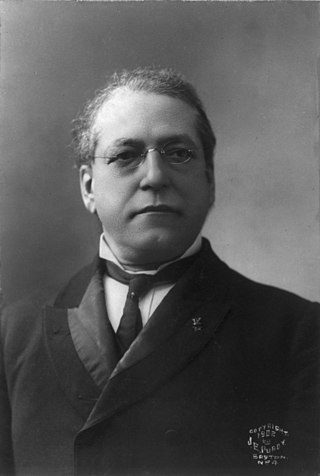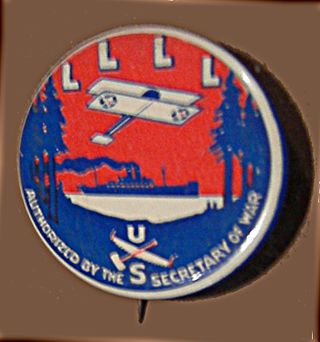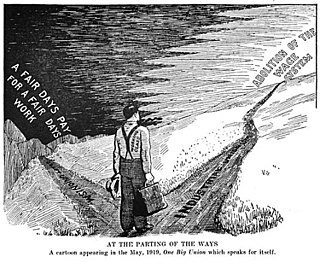| Founded | 1917 |
|---|---|
| Dissolved | 1924 |
| Location | |
Members | 20,000 |
| Affiliations | Industrial Workers of the World, One Big Union |
The Lumber Workers' Industrial Union (LWIU) was a labor union in the United States and Canada which existed between 1917 and 1924. It organised workers in the timber industry and was affiliated with the Industrial Workers of the World (IWW).
Between 1915 and 1917, the Agricultural Workers Organization (AWO) of the IWW organized hundreds of thousands of migratory farm workers throughout the midwest and western United States. Building on the success of the AWO, the IWW's LWIU used similar tactics to organize lumberjacks and other timber workers, both in the Deep South and the Pacific Northwest of the United States and Canada, between 1917 and 1924. The IWW lumber strike of 1917 led to the eight-hour day and vastly improved working conditions in the Pacific Northwest. Even though mid-century historians would give credit to the US Government and "forward thinking lumber magnates" for agreeing to such reforms, an IWW strike forced these concessions. [1]
The LWIU briefly joined the One Big Union organization in Canada. But that organization differed structurally from the IWW. While the IWW organized on industrial lines, the OBU of Canada focused more on organizing workers geographically. [2] The absence of an existing industrial union structure within the Canadian OBU caused the LWIU to pull out its 20,000 members. According to the 1922 publication Industrial Unionism in America, "Their withdrawal was a staggering blow from which the O. B. U. [never] recovered." [3]
In 1924 the IWW was split by a division between centralizers and decentralizers. The modern IWW website describes an offshoot led by James Rowan of the LWIU, who invoked the E-P (Emergency Program.) "The E-Pers believed that the administration of the IWW was too strongly emphasizing 'Political Action' as opposed to Organizing on the Job. The E-P claimed to oppose 'centralism' in favor of 'decentralism', but the E-P sought to centralize power within individual Industrial Unions." [4]

The Industrial Workers of the World (IWW), nicknamed "Wobblies", is an international labor union founded in Chicago in 1905. The nickname's origin is uncertain. Its ideology combines general unionism with industrial unionism, as it is a general union, subdivided between the various industries which employ its members. The philosophy and tactics of the IWW are described as "revolutionary industrial unionism", with ties to socialist, syndicalist, and anarchist labor movements.
Industrial unionism is a trade union organising method through which all workers in the same industry are organized into the same union, regardless of skill or trade, thus giving workers in one industry, or in all industries, more leverage in bargaining and in strike situations.

Samuel Gompers was a British-born American cigar maker, labor union leader and a key figure in American labor history. Gompers founded the American Federation of Labor (AFL) and served as the organization's president from 1886 to 1894, and from 1895 until his death in 1924. He promoted harmony among the different craft unions that comprised the AFL, trying to minimize jurisdictional battles. He promoted thorough organization and collective bargaining in order to secure shorter hours and higher wages, which he considered the essential first steps to emancipating labor.

The One Big Union is an idea originating in the late 19th and early 20th centuries amongst trade unionists to unite the interests of workers and offer solutions to all labour problems.
Craft unionism refers to a model of trade unionism in which workers are organised based on the particular craft or trade in which they work. It contrasts with industrial unionism, in which all workers in the same industry are organized into the same union, regardless of differences in skill.
Labor aristocracy or labour aristocracy has at least four meanings: (1) as a term with Marxist theoretical underpinnings; (2) as a specific type of trade unionism; (3) as a shorthand description by revolutionary industrial unions for the bureaucracy of craft-based business unionism; and (4) in the 19th and early 20th centuries was also a phrase used to define better-off members of the working class.

The Workers' International Industrial Union (WIIU) was a Revolutionary Industrial Union headquartered in Detroit in 1908 by radical trade unionists closely associated with the Socialist Labor Party of America, headed by Daniel DeLeon. The organization was formed when it broke with the main faction of the Industrial Workers of the World (IWW) over the question of political action.

The Loyal Legion of Loggers and Lumbermen (LLLL), commonly known as the "Four L" (4L), was a company union found in the United States during World War I in 1917 by the War Department as a counter to the Industrial Workers of the World.
Labor federation competition in the United States is a history of the labor movement, considering U.S. labor organizations and federations that have been regional, national, or international in scope, and that have united organizations of disparate groups of workers. Union philosophy and ideology changed from one period to another, conflicting at times. Government actions have controlled, or legislated against particular industrial actions or labor entities, resulting in the diminishing of one labor federation entity or the advance of another.

The American Labor Union (ALU) was a radical labor organization launched as the Western Labor Union (WLU) in 1898. The organization was established by the Western Federation of Miners (WFM) in an effort to build a federation of trade unions in the aftermath of the failed Leadville Miners' Strike of 1896. The group changed its name from WLU to the more familiar ALU moniker in 1902 at its fifth annual convention. The group had a peak membership of about 43,000 — of which 27,000 were members of the WFM. The ALU was a precursor to the Industrial Workers of the World (IWW), established in 1905, which effectively terminated it.
Wobbly lingo is a collection of technical language, jargon, and historic slang used by the Industrial Workers of the World, known as the Wobblies, for more than a century. Many Wobbly terms derive from or are coextensive with hobo expressions used through the 1940s.
The Scranton Declaration, sometimes called the Autonomy Declaration, was passed in 1901 by the American Federation of Labor (AFL) and made craft autonomy, or craft unionism, the cornerstone of the organization. Craft unionism meant that unions were formed on the basis of the trade practiced by a group of skilled workers, in contrast to industrial unionism.

The Industrial Workers of the World (IWW) is a union of wage workers which was formed in Chicago in 1905 by militant unionists and their supporters due to anger over the conservatism, philosophy, and craft-based structure of the American Federation of Labor (AFL). Throughout the early part of the 20th century, the philosophy and tactics of the IWW were frequently in direct conflict with those of the AFL concerning the best ways to organize workers, and how to best improve the society in which they toiled. The AFL had one guiding principle—"pure and simple trade unionism", often summarized with the slogan "a fair day's pay for a fair day's work." The IWW embraced two guiding principles, fighting like the AFL for better wages, hours, and conditions, but also promoting an eventual, permanent solution to the problems of strikes, injunctions, bull pens, and union scabbing.
The Grabow riot or Grabow massacre was a violent confrontation that took place between private police hired by management and labor factions in the timber industry near Grabow (Graybow), Louisiana, on July 7, 1912. The clash left three union workers and a company security employee dead, including union leader Asbury Decatur ("Kate") Hall, and an estimated fifty wounded. It was a crucial event in attempts to organize locals and unionize sawmill workers in Louisiana and east Texas in a series of events known as the Louisiana-Texas Lumber War of 1911-1912.
The Agricultural Workers Organization (AWO), later known as the Agricultural Workers Industrial Union, was an organization of farm workers throughout the United States and Canada formed on April 15, 1915, in Kansas City. It was supported by, and a subsidiary organization of, the Industrial Workers of the World (IWW). Although the IWW had advocated the abolition of the wage system as an ultimate goal since its own formation ten years earlier, the AWO's founding convention sought rather to address immediate needs, and championed a ten-hour work day, premium pay for overtime, a minimum wage, good food and bedding for workers. In 1917 the organization changed names to the Agricultural Workers Industrial Union (AWIU) as part of a broader reorganization of IWW industrial unions.
The Industrial Workers of the World (IWW) is a union of wage workers which was formed in Chicago in 1905. The IWW experienced a number of divisions and splits during its early history.
The Metal and Machinery Workers Industrial Union No. 440 (MMWIU) was a labor union in the United States which existed from 1907 to 1950. It organized workers in the manufacturing industry and was affiliated with the Industrial Workers of the World (IWW).

The Industrial Workers of the World (South Africa) or IWW (SA) had a brief but notable history in the 1910s-20s, and is particularly noted for its influence on the syndicalist movement in southern Africa through its promotion of the IWW's principles of industrial unionism, solidarity, and direct action, as well as its role in the creation of organizations such as the Industrial Workers of Africa and the Industrial and Commercial Workers' Union.
The Louisiana and Texas Lumber War of 1911–1912 was a series of worker strikes that fought for better conditions in sawmills in the Piney Woods of west Louisiana and East Texas. These sawmills underwent attempts to unionize that were opposed by lumber companies and owners. The union workers were known as the Brotherhood of Timber Workers (BTW), a branch of the Lumber Workers Industrial Union (LWIU), which was affiliated with the Industrial Workers of the World (IWW). The Brotherhood tried to recruit mill workers by giving speeches and conducting meetings at various mills. Although they had limited success in Louisiana, the LWIU became very successful from 1917 to 1924.
The 1916–1917 northern Minnesota lumber strike was a labor strike involving several thousand sawmill workers and lumberjacks in the northern part of the U.S. state of Minnesota, primarily along the Mesabi Range. The lumber workers were organized by the Industrial Workers of the World (IWW) and primarily worked for the Virginia and Rainy Lake Lumber Company, whose sawmill plant was located in Virginia, Minnesota. Additional lumberjacks and mill workers from the International Lumber Company were also involved. The strike first began with the Virginia and Rainy Lake mill workers on December 28, 1916, and among the lumberjacks on January 1, 1917. The strike lasted for a little over a month before it was officially called off by the union on February 1, 1917. Though the strike faltered by late January and had resulted in many arrests and the suppression of the IWW's local union in the region, the union claimed a partial victory, as the lumber companies instituted some improvements for the lumberjacks' working conditions.